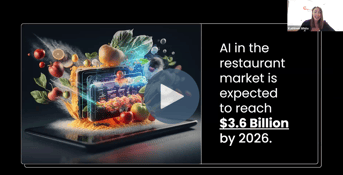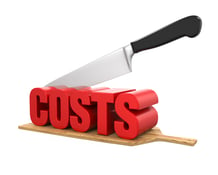When it comes to restaurant planning and long-term management, efficiency is your only option. Tasty recipes, a savvy staff, and a heavy helping of curb appeal won’t help you if you can’t maintain efficient operations.
Making decisions with efficiency in mind helps restaurant operators address many of the challenges inherent to their industry. High turnover, stiff competition, slim margins, waste – they’re always a threat, but they don’t have to keep you up at night. They’ll hardly bother you at all if you constantly look for opportunities to emphasize efficiency.
Why is efficiency important for a restaurant?
Unless you’re running a quick-service establishment – in which case getting in and out as speedily as possible is the name of the game – your customers might not notice that you’re running at peak efficiency. Hopefully, they’ll be too engrossed in their food and too entranced by the atmosphere to wonder at what’s going on behind the scenes. You can bet, however, that diners will recognize an inefficient restaurant when they experience one.
When efficiency is lacking, your customers are often the first to pay the price. They’ll wait longer for tables whether or not they’ve booked reservations. They’ll groan with disappointment when they learn that inefficient inventory management has caused the menu to shrink. They’ll grow more and more frustrated when their orders get mixed up and the check seems to take forever. Ultimately, they’ll feel more compelled to vent their frustrations online than to give your restaurant a second chance.
That’s when you’ll start to feel the consequences of poor restaurant planning and long-term inefficiency. Your employees will get frustrated with all the miscommunication, you’ll sit on surpluses or find yourself without crucial inventory, and, worst of all, you’ll see revenue drop. From there, it’s potentially just a matter of time before you shut your doors for good.
Improve restaurant efficiency with these core principles
No restaurant can operate at peak efficiency all the time, but a reputation for high-efficiency operations is worth striving for. From the front of the house to back of the house certain core principles should drive your restaurant planning and inform decision making to ensure you’re always acting on opportunities to improve restaurant efficiency.
Invest in your staff
Your people are your most important investment. Talk to any successful restaurateur and they’ll tell you the same thing. When you make a commitment to empowering your team, they’ll commit to giving their all in the name of mutual goals. Instill the value of efficiency as early as possible and make it a core component of your culture. Set a good example by executing an efficient interview and hiring process.
Cross-training opportunities will keep your employees motivated while also making it simpler to efficiently staff the restaurant during busy hours. It’s not realistic to expect everyone to do everything, but blurring the distinction between front and back of house could result in more engagement and enthusiasm.
Communication is key
Poor communication is among the primary causes of inefficiency in restaurants. When communication falters, both your staff and customers suffer. Keeping everyone in the loop and stressing clarity at all times will help you avoid the mishaps and mistakes that disappoint customers and distress staff members.
Aside from in-person communication, clear and accessible documents are critical for restaurant planning and long-term management. Systems for documenting standard operating procedures, addressing FAQs, and iterating on feedback will contribute to an ongoing conversation and ensure the full team is involved in continually improving efficiency.
Embrace technology
Don’t let the click-chasing headlines scare you. Far from replacing the restaurant workforce, emerging solutions powered by artificial intelligence and other advanced tech promise to augment human capabilities and enable a new level of customer service.
At the front of the house, solutions for reservation management and payment processing provide a wait-free dining experience while making it easier to collect valuable customer data. With all that data, you’ll grow all the more efficient thanks to predictive capabilities.
Take care not to simply chase the latest trends. Carefully review your purchases and ensure the whole team understands the ways new technology will (and won’t) affect their day-to-day experience. Remember, effective communication goes a long way in establishing and maintaining efficient restaurant operations.
You’ll notice that these principles go hand in hand. Cutting-edge technology facilitates better communication and offers performance insights to guide professional development. Keeping lines of communication open raises your chances of landing on the right innovation and shows your staff how much you care. These principles also share an end-to-end quality, they help to improve restaurant efficiency from the front of house to the back.
Tips to improve front of house efficiency
First impressions go a long way with restaurant-goers. Keeping the front of house efficient sets the stage for memorable experiences and builds a loyal community of dedicated customers who keep coming back because they always know what to expect.
Make it seamless
Leaning on technology to streamline the restaurant experience helps reduce the risk of human error, eliminate tedious tasks from your front-of-house team’s workloads, and simplify data collection. With automated systems for managing reservations, an integrated POS system, and other time-saving tools, you’ll make sure customers are focused on food and conversation instead of sitting and waiting.
Stay simple
Introducing complications means inviting the risk of inefficiency. When you’re picking technology, laying out a floor plan for your seating, or designing your menu, remember that sometimes simplest is best. If you’re introducing a loyalty program, for example, don’t force patrons to make sense of complicated rules or undergo a lengthy sign-up process.
Listen to your customers
From rave reviews to harsh critiques, your customers have plenty of wisdom to offer. Take every opportunity you can to get their take on how you might refine your operations and improve customer service. Try getting creative to incentivize feedback. You might enter survey participants into a raffle or offer discounts to everyone who participates before a certain date.
Back of house best practices
Whether you’re showing off behind-the-scenes action with an open kitchen or not, you’ll need to enforce efficiency standards to keep your team and customers happy.
Take planning and organization seriously
Busy restaurants sometimes demand improvisation, but you should strive to leave as little up to chance and interpretation as possible. Establishing solid standard operating procedures for core processes as well as emergencies will help your team move quickly and decisively no matter what happens. On a more abstract level, the restaurant planning stage offers an opportunity to establish the right cultural pillars.
Proactively manage equipment
From the advanced technology helping you generate performance insights to the kitchen gear you depend on to feed hungry customers, all your equipment needs preventive maintenance. Sticking to a schedule, documenting performance insights, and standardizing maintenance processes will help limit the risk of unexpected breakdowns and maximize the lifetime of your equipment.
Set goals and track progress
All the data you collect and the conversations you have with customers and staff should support ongoing efforts to improve restaurant efficiency. Every decision you make should help you make progress toward your strategic goals. Having trouble meeting your objectives? Dig into the data, consult your staff, and outline steps for taking corrective action.
Don’t get too comfortable. Your efficiency standards and best practices should evolve over time as customer tastes change, competitors arise, and market forces shift.





